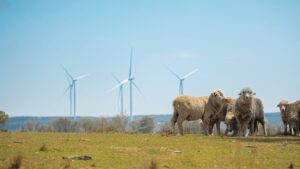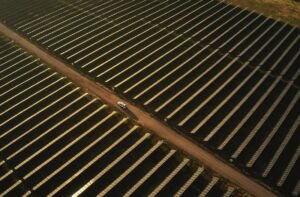
A preliminary report into last week’s blackout in South Australia from the Australian Energy Market Operator says it is clear that it was a “weather event” that sparked 30 seconds of chaos and triggered the collapse of three main transmission lines and ultimately the state-wide blackout.
But the report, although reaching no conclusions, and based on incomplete data, invites the media – and wind farm opponents in Coalition and industry – to cite wind energy as a key factor by inferring that some of the state’s wind farms contributed to the cascading impacts that caused the state-wide outage.
The report was released on Wednesday morning, just two days before a hastily convened COAG energy minister’s meeting on Friday.
This is grist for the mill for that meeting – and it appears its timing serves no other purpose. No doubt it will be seized upon by the Coalition in its campaign against wind farms and its attempts to stop the states from going forward with their own renewable energy programs.
In particular, the Coalition will point to the loss of 315MW of wind power highlighted by AEMO in the press release after the collapse of the last of the transmission lines that preceded the failure of the inter-connector. At which point all the remaining gas and wind generators tripped.

But there is a question about whether this loss of wind capacity really mattered. The data in the actual report suggests not.
Wind generators were producing a total of 883MW at the time (gas was providing 330MW and 613MW was coming from Victoria) – and had ridden out the loss of the first two transmission lines.
A small amount of wind capacity dropped out after the second transmission line collapsed, possibly – the operators say – as the result of lightning strikes and a software glitch that has since been rectified.
But as this chart below shows, there was no impact on frequency. It was only the failure of the third transmission line at 1615.18 that some generation was lost, the frequency dropped the system went black 1.2 seconds later.
The loss of the third transmission line took away the delivery mechanism for two other wind farms, which suggests it wouldn’t have mattered which power source was operating on that line. Within another half a second, all remaining gas and wind plants had gone after the interconnector tripped.

The report does not say why this happened, or why they stopped generating. It could be because they had nowhere to send their output. Or that, as mentioned earlier, some were hit by lightning, or tripped after repeated voltage drops.
Nor does the report does not say if the total blackout would avoided by having a brown coal generator on line, or if the outcome would have been any different with no wind power.
The report also point to problems with conventional generation, saying that contracted but un-named providers of “black start” services – peaking gas fired and diesel power stations – failed to deliver and could not be used to restart the main gas generator, meaning the operator had to wait until a new link was established with Victoria.
They are paid millions of dollars to provide this essential service, but failed when needed. The report does not say why, possibly because it won’t even say who.
Indeed, the report is also likely to trigger discussions about the role of AEMO itself, and the actions that it took, or didn’t take, in the lead up to the blackout.
It says, for instance, that it was on a “heightened state of readiness” with “emergency procedures in place”.
But market players are wondering why it saw no reason to allocate more back-up power, or adjust the flow on the interconnector so that they could respond to any unforeseen events, particularly for the lightning that is frequent in that part of the world.
If it had “reclassified” the potential loss of the interconnector, this would have invoked the provision of 35MW of local FCAS constraint and constrained the interconnector, leaving enough headroom to manage this power flow increase.
Already, the question is being asked: how serious does a storm have to be, and who made the call that this was not serious enough? Many in the market are also expecting a review of the fault ride-through equipment and systems that are rarely tested in real-time.
AEMO has already taken some preventative measures in the interim, placing constraints on wind farms and taking control of the wholesale market – essentially running it as a centrally controlled system rather than an open energy market.
The reason for this is the continued absence of the three main transmission lines, and some smaller lines, which are unprecedented and beyond the system design. It has also reclassified 10 wind farms that it says “did not operate” normally during the weather events.
It effectively means their combined output cannot exceed 600MW, or that of the interconnector. It says this will remain in place until more is known about the issues. AEMO wants to see high speed data from all wind farms in the region in order to confirm that each generator performed in line with their respective agreements.
The preliminary report explains how severe weather moved through South Australia on the afternoon of Wednesday, September 28, with high winds, thunderstorms, 80,000 lightning strikes, hail, and heavy rainfall and even two tornadoes.
The weather, it said, resulted in multiple transmission system faults including, and in the space of 12 seconds, the loss of three major 275 kV transmission lines north of Adelaide.

The sequence of events as described by AEMO went something like this:
– At 1618 (network time): One line faulted: No change to generation or load. … but 1 transmission line out of service
– Another line faulted (and successful re-connected within 1 second). Then it re-faulted and 2 transmission lines out of service.
– 1 second later, there was about 123MW reduction in wind output.
– 4 seconds later – another transmission fault …. and now 3 transmission lines were out of service
– About 2 seconds later another about 192MW reduction in wind output occurred. This caused the flow across Heywood Interconnector to increase to over 850MW, causing it to trip. In less than half a second the whole state went to “system black”.
The cause of wind farm disconnection is still not clear and is not dealt with by AEMO. There is some suggestion that some wind farms could have been lost because of multiple lightning strikes, or because of protection measures.
Strikes at some turbines may have triggered an automatic shutdown after three successive faults – although these faults could have been caused by lightning or falls in frequency. There are concerns that these turbines should have been configured to ride through more such events.
It wouldn’t be the first time lightning has caused havoc in South Australia. In 2005, a lightning strike forced the Northern brown coal generator to drop from nearly full output to zero, causing the inter-connector to trip and the loss of a number of other conventional power plants.
Still, these are troubling times for the wind industry, and for the solar industry as well, which could also find itself impacted should the states find themselves beaten into submission by the federal government and a baying media crowd.

South Australia premier Jay Weatherill says the report shows that it was a weather event and was not a “renewable energy” event.
“Now, armed with that information, we need to attend the national energy ministers meeting on Friday to take steps to ensure that we have a secure, clean and affordable electricity system,” he was quoted as saying by the ABC.
Prime minister Malcolm Turnbull, however, said the state had failed to keep the lights on. “SA has the highest wholesale energy costs in Australia. That is not good for business. It’s not good for a state which needs to get more jobs, [and has] a higher unemployment rate than any other.”
The Clean Energy Council says it was clear that the blackout was caused by the storm that took out the huge electricity pylons and triggered a sequence of “extraordinary events”, and it wouldn’t have mattered if the state was running on coal, gas, nuclear or renewable energy.
“This was a once-in-50-year storm which placed extraordinary stress on the power system, and the cascading events that followed the damage to the transmission system have never been experienced before,” CEO Kane Thornton said.
“Australia’s power network is highly sophisticated with a range of advanced protection and fault ride-through equipment and systems that are rarely tested in real-time. These were put under unprecedented pressure due to the extreme weather events in South Australia.
“No doubt there will be much we can learn to improve the resilience of the electricity system in light of the evolving energy mix and the probability of increased storm events in the future.
“There is no evidence to suggest that maintaining Northern Power Station in operation or the increased role of wind power changed the outcome in these extraordinary events.”








